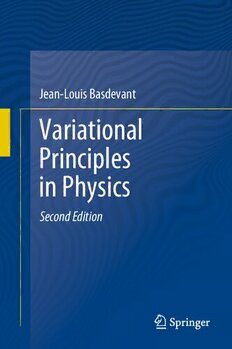Table Of ContentJean-Louis Basdevant
Variational
Principles
in Physics
Second Edition
Variational Principles in Physics
Jean-Louis Basdevant
Variational Principles
in Physics
Second Edition
Jean-LouisBasdevant
ProfesseurHonoraire
DépartementdePhysique
ÉcolePolytechnique
Paris,France
ISBN 978-3-031-21691-6 ISBN 978-3-031-21692-3 (eBook)
https://doi.org/10.1007/978-3-031-21692-3
OriginalFrencheditionpublishedbydeBoeckSuperieurS.A.,Louvain-la-Neuve,Belgium,2022
1stedition:©SpringerScience+BusinessMedia,LLC2007
2ndedition:©TheEditor(s)(ifapplicable)andTheAuthor(s),underexclusivelicensetoSpringer
NatureSwitzerlandAG2023
Thisworkissubjecttocopyright.AllrightsaresolelyandexclusivelylicensedbythePublisher,whether
thewholeorpartofthematerialisconcerned,specificallytherightsofreprinting,reuseofillustrations,
recitation,broadcasting,reproductiononmicrofilmsorinanyotherphysicalway,andtransmissionor
informationstorageandretrieval,electronicadaptation,computersoftware,orbysimilarordissimilar
methodologynowknownorhereafterdeveloped.
Theuseofgeneraldescriptivenames,registerednames,trademarks,servicemarks,etc.inthispublication
doesnotimply,evenintheabsenceofaspecificstatement,thatsuchnamesareexemptfromtherelevant
protectivelawsandregulationsandthereforefreeforgeneraluse.
Thepublisher,theauthors,andtheeditorsaresafetoassumethattheadviceandinformationinthisbook
arebelievedtobetrueandaccurateatthedateofpublication.Neitherthepublishernortheauthorsor
theeditorsgiveawarranty,expressedorimplied,withrespecttothematerialcontainedhereinorforany
errorsoromissionsthatmayhavebeenmade.Thepublisherremainsneutralwithregardtojurisdictional
claimsinpublishedmapsandinstitutionalaffiliations.
ThisSpringerimprintispublishedbytheregisteredcompanySpringerNatureSwitzerlandAG
Theregisteredcompanyaddressis:Gewerbestrasse11,6330Cham,Switzerland
Preface
AttheEcolePolytechnique,mymajorteachingactivitywasthegeneralcourseon
QuantumMechanics,butIhadmanyopportunitiestogetinterestedinotherfields
such as Statistical physics, Particle physics, Energy and the environment. The last
courseIconstructedconcernedVariationalPrinciplesinPhysics.Actually,thiswas
unexpected:Ihadtoreplaceacolleague.
Ihadnotthoughtaboutthatsubjectanditwasreallyadiscoverythattherewas
muchmorethanwhatIcouldteach.ButIwasluckyenoughtohaveaninteresting
groupofstudentsandcolleagueswhowerehappywhenItoldthemwewouldlearn
physicstogether.Thespiritwasexcellent,andtogetherwediscoveredmanyaspects
oftheevolutionofphysicsinthemindsofcreativepeople.
In the meantime, two basic results occurred in fundamental physics. First, in
July 2012, the discovery, at the CERN Large Hadron Collider, of the long antici-
patedHiggsBosonwhichcompleted,insomesense,theStandardModelofParticle
Physics. On 8 October 2013, the Nobel Prize in Physics was awarded jointly to
FrancoisEnglertandPeterHiggs“forthetheoreticaldiscoveryofamechanismthat
contributestoourunderstandingoftheoriginofmassofsubatomicparticles...”.A
year after, great news occurred with the discovery of the first gravitational waves
observedonSeptember14,2015,bytheLIGOandVirgolaboratories,onehundred
years after their prediction by Einstein. These will remain the two most important
physicaldiscoveriesofthefirstpartofthetwenty-firstcentury.
ThephysicsoftheHiggsfieldistoofarfromthepurposeofthisbook.Butitwas
obviouslyamusttoaddanewchapterongravitationalwavestothe2007editionof
“VariationalPrinciplesinPhysics”.Mycolleagues andstudentssaidthatalthough
variationalprinciplesareintellectuallyattractive,ifonedoesnotshowwhattheyaim
at,theymayseemformal.
Another example is the fact that, around 1840, Hamilton was fascinated by an
unknown fact: geometrical optics should be considered as a limiting case of wave
optics, and classical mechanics seems to be a similar limit of some yet unknown
mechanical theory, but which theory? In 1890, the mathematician Felix Klein
deploredthatnoonehadpursuedthatidea.But35yearslater,someofthe“fathers”
ofquantummechanics,suchasDiracandLouisdeBroglie,gainedmuchinspiration
v
vi Preface
fromreadingHamilton’sworks.Furthermore,aswedevelopandexplaininChap.9,
Richard Feynman in his 1942 Ph.D. dissertation at Princeton, constructed a new
versionofquantummechanics:Theprincipleofleastactioninquantummechanics,
based on very simple axioms on probability amplitudes, and on the analogy with
Hamilton’s“Characteristicfunction”.Thisisanimportantprogress,inparticular,to
displayinasimpleway,analogoustotheHuygens–Fresnelprinciple,howclassical
mechanicsderivesasthelimitofquantummechanics.Onecanfollowthisinthenew
lastchapter,whichhasbeenconsiderablyincreased,inrelationtothenewChap.5
onHamilton’sviewofopticsanditssimilaritywithmechanics.
AsimilarremarkholdsforGeneralRelativity.Manymathematiciansofthenine-
teenthcentury,suchasGauss,Riemann,andLobachevsky,wereinterestedincurved
spaces.IntheLagrange–Hamiltonframework,itispossibletoseethatthefreemotion
ofaparticleinacurvedspaceisindependentoftheparticle’smass,sothattheequiv-
alenceprincipleofinertialandgravitationalmassisachieved,providedthecurvature
givesagoodtrajectory.ThemathematicalworkofEinsteinandMarcelGrossmann
consistedoffindingthecurvatureofspace–timethattakesintoaccountgravitation.
Laws of nature appear to follow rules expressed mathematically as variational
principles. These principles possess two characteristics. First, they are universal.
Secondly,theyexpressphysicallawsastheresultsofoptimalequilibriumconditions
betweenconflictingcauses.Inotherwords,theypresentnaturalphenomenaasprob-
lemsofoptimizationunderconstraints.Thefoundingideaofmodernphysicsisdue
to Fermat and his least time principle in optics. This was further developed in the
frameworkofthecalculusofvariationsofEulerandLagrange.In1744,Maupertuis
foundtheleastactionprincipleinmechanics.
Thephilosophicalimpactofthediscoveryofsuchprinciplesofnaturaleconomy
wasconsiderableintheeighteenthcentury.However,themetaphysicalenthusiasm
didnotlastlongbecausevariationalprincipleshaveconstantlyproducedmoreand
more profound physical results, many of which underlie contemporary theoretical
physics.Theambitionofthisbookistodescribesomeoftheirphysicalapplications.
Wewillseehowsuchideashavegeneratedmostifnotallphysicalconceptsofthe
presenttime.
Afterpresentingandanalyzingsomeexamples,thecoreofthisbookisdevoted
totheanalyticalmechanicsofLagrangeandHamilton,whichisamustintheculture
ofanyphysicistofourtime.Thetoolsthatwedevelopwillalsobeusedtopresent
theprinciplesofLagrangianfieldtheory.
Wethenstudythemotionofaparticleinacurvedspace.Thisallowsustohavea
simplebutrichtasteofgeneralrelativityanditsfirstandmostfamousapplications
amongwhichgravitationalopticsallowsustoprobetheuniverseatveryfardistances,
aswellastheGPSguidingsystem.
At this point, we can penetrate General Relativity and Einstein’s equations by
analyzingtheproductionandthereceptionofthegravitationalwavesthatwehave
mentionedaboveandweredetectedonearth.
Inthelastchapter,wepresentanewversionofthetheoryofFeynmanpathintegrals
inquantummechanics.WeshallthenbeabletoappreciatehowclosetheFeynman
approach is to direct intuitive quantities, space and time, to the ensuing extension
Preface vii
of these ideas to a relativistic approach, and to prove that classical mechanics is
thelimitofquantummechanicswhenPlanck’sconstant(cid:2)isnegligiblecomparedto
otherphysicalquantities.
I was struck by the interest that students found in this aspect of physics. They
discoveredaculturalcomponentofsciencethattheydidnotexpect.Forthatreason,
teachingthiswasaveryrewardingpieceofwork.
IwarmlythankProf.ChristophKopper,whotookoverthiscourseattheEcole
Polytechnique.IowemuchtoDavidLanglois,AssociateProfessorwhoallowedme
to study his course and his book on General Relativity. I am extremely grateful to
mycolleagueAndréRougéforhisusefulcommentsandsuggestions.
IamverygratefultoJamesRich,whowasabletoextractmefromthetraditional
Frenchacademismandmakemesharehiscreativeenthusiasmforphysics.Partof
Chap.7isdirectlyinspiredbyhisworkinadifferentcontext.
IthankmycolleaguesandfriendsAdelBilal,FrançoisJacquet,andJean-François
Rousselforalltheircommentsandsuggestionswhenwewereteachingthismatter
andhavingfuntogether.
ImustthankmymathematiciancolleaguesJean-MichelBony,Jean-PierreBour-
guignonandAlainGuichardet.Theyhelpedmetoavoidspendingtimeondifficult
problemsthatwerenotnecessary.
Finally,Iwanttothankmystudents,inparticularClaireBiot,AmélieDeslandes,
Juan Luis Astray Riveiro, Clarice Aiello Demarchi, Joëlle Barral, Zoé Fournier,
CélineVallot,andJulienBoudet,fortheirquestionsandtheirkindcomments.They
have provided this book with a flavor and a spirit of youth that would have been
absentwithoutthem.
Paris,France Jean-LouisBasdevant
September2022
Contents
1 StructureofPhysicalTheories .................................. 1
2 VariationalPrinciples .......................................... 11
2.1 Fermat’sLeastTimePrinciple ................................ 13
2.2 VariationalCalculusofEulerandLagrange .................... 17
2.2.1 FirstIntegrals,CyclicVariables ........................ 18
2.2.2 MiragesandCurvedRays ............................. 19
2.3 Maupertuis,PrincipleofLeastAction ......................... 22
2.3.1 ElectrostaticPotential ................................ 23
2.4 ThermodynamicEquilibrium:MaximalDisorder ................ 25
2.4.1 PrincipleofEqualProbabilityofStates .................. 25
2.4.2 MostProbableDistributionandEquilibrium ............. 26
2.4.3 LagrangeMultipliers ................................. 27
2.4.4 BoltzmannFactor .................................... 27
2.4.5 EqualizationofTemperatures .......................... 29
2.4.6 TheIdealGas ....................................... 30
2.4.7 Boltzmann’sEntropy ................................. 31
2.4.8 HeatandWork ...................................... 32
2.5 Exercises .................................................. 33
2.6 Problem.WinaDownhill .................................... 35
3 TheAnalyticalMechanicsofLagrange ........................... 37
3.1 LagrangianFormalismandLeastAction ....................... 39
3.1.1 LeastActionPrinciple ................................ 39
3.1.2 Lagrange–EulerEquations ............................ 40
3.1.3 OperationoftheOptimizationPrinciple ................. 43
3.2 InvariancesandConservationLaws ........................... 43
3.2.1 ConjugateMomentaandGeneralizedMomenta .......... 44
3.2.2 CyclicVariables ..................................... 44
3.2.3 EnergyandTranslationsinTime ....................... 45
3.2.4 NoetherTheorem:SymmetriesandConservationLaws .... 47
3.2.5 MomentumandTranslationsinSpace ................... 48
ix
x Contents
3.2.6 AngularMomentumandRotations ..................... 48
3.2.7 DynamicalSymmetries ............................... 49
3.3 Velocity-DependentForces .................................. 50
3.3.1 DissipativeSystems .................................. 50
3.3.2 LorentzForce ....................................... 51
3.3.3 GaugeInvariance .................................... 53
3.3.4 Momentum ......................................... 53
3.4 LagrangianofaRelativisticParticle ........................... 54
3.4.1 LorentzTransformation ............................... 54
3.4.2 FreeParticle ......................................... 55
3.4.3 EnergyandMomentum ............................... 56
3.4.4 InteractionwithanElectromagneticField ............... 57
3.5 Exercises .................................................. 59
3.6 Problem.StrategyofaRegatta ............................... 60
4 Hamilton’sCanonicalFormalism ................................ 63
4.1 Hamilton’sCanonicalFormalism ............................. 65
4.1.1 CanonicalEquations .................................. 65
4.2 PoissonBrackets,PhaseSpace ............................... 66
4.2.1 TimeEvolution,ConstantsoftheMotion ................ 67
4.2.2 RelationBetweenAnalyticalandQuantumMechanics .... 68
4.3 CanonicalTransformationsinPhaseSpace ..................... 70
4.4 EvolutioninPhaseSpace:Liouville’sTheorem ................. 74
4.5 ChargedParticleinanElectromagneticField ................... 75
4.5.1 Hamiltonian ......................................... 76
4.5.2 GaugeInvariance .................................... 76
4.6 DynamicalSystems ......................................... 77
4.6.1 TheContributionofHenriPoincaré ..................... 77
4.6.2 PoincaréandChaosintheSolarSystem ................. 78
4.6.3 Poincaré’sRecurrenceTheorem ........................ 79
4.6.4 TheButterflyEffect;theLorenzAttractor ............... 80
4.7 Exercises .................................................. 82
4.8 Problem.ClosedChainofCoupledOscillators .................. 84
5 Action,Optics,Hamilton-JacobiEquation ........................ 87
5.1 GeometricalOptics,CharacteristicFunctionofHamilton ......... 89
5.2 ActionandtheHamilton-JacobiEquation ...................... 92
5.2.1 TheActionasaFunctionofCoordinatesandTime ........ 92
5.2.2 LeastActionPrinciple ................................ 94
5.2.3 Hamilton-JacobiEquation ............................. 95
5.2.4 ConservativeSystems,ReducedAction,Maupertuis
Principle ............................................ 96
5.3 Semi-ClassicalApproximationinQuantumMechanics .......... 98
5.4 Hamilton-JacobiFormalism .................................. 100
5.5 Exercises .................................................. 102
Contents xi
6 LagrangianFieldTheory ....................................... 105
6.1 VibratingString ............................................ 106
6.2 FieldEquations ............................................ 107
6.2.1 GeneralizedLagrange–EulerEquations ................. 107
6.2.2 HamiltonianFormalism ............................... 108
6.3 ScalarField ................................................ 110
6.4 ElectromagneticField ....................................... 110
6.5 EquationsofFirstOrderinTime .............................. 114
6.5.1 DiffusionEquation ................................... 114
6.5.2 SchrödingerEquation ................................. 115
6.6 Problem ................................................... 116
7 MotioninaCurvedSpace ....................................... 117
7.1 TheEquivalencePrinciple ................................... 117
7.2 CurvedSpaces ............................................. 119
7.2.1 Generalities ......................................... 119
7.2.2 TheLightRays,GeodesicsofOurSpace ................ 120
7.2.3 MetricTensor ....................................... 121
7.2.4 Examples ........................................... 122
7.3 FreeMotioninaCurvedSpace ............................... 123
7.3.1 Lagrangian .......................................... 124
7.3.2 EquationsofMotion .................................. 124
7.3.3 SimpleExamples .................................... 125
7.4 GeodesicLines ............................................. 127
7.4.1 Definition ........................................... 127
7.4.2 EquationoftheGeodesics ............................. 128
7.4.3 Examples ........................................... 129
7.4.4 MaupertuisPrincipleandGeodesics .................... 131
7.5 GravitationandtheCurvatureofSpace-Time ................... 133
7.5.1 NewtonianGravitationandRelativity ................... 133
7.5.2 TheSchwarzschildMetric ............................. 134
7.5.3 GravitationandTimeFlow ............................ 136
7.5.4 PrecessionofMercury’sPerihelion ..................... 136
7.5.5 GravitationalDeflectionofLightRays .................. 141
7.6 GravitationalOpticsandMirages ............................. 144
7.6.1 GravitationalLensing ................................. 145
7.6.2 GravitationalMirages ................................. 145
7.6.3 ObservationofaDoubleQuasar ........................ 147
7.6.4 BaryonicDarkMatter ................................ 151
7.7 Exercises .................................................. 155
7.8 Problem.MotionontheSphereS3 ............................ 157

